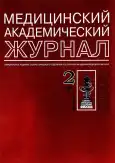Influenza viruses with pandemic potential and measures to prevent their emergence
- Authors: Kuznetsov O.K.1, Kiselev O.I.1
-
Affiliations:
- Research Institute of Influenza of the Russian Academy of Medical Sciences
- Issue: Vol 3, No 2 (2003)
- Pages: 112-121
- Section: Preventive medicine
- Published: 06.06.2003
- URL: https://journals.eco-vector.com/MAJ/article/view/693223
- ID: 693223
Cite item
Abstract
Based on the analysis of current data presented in scientific publications five main theses on emergence of influenza viruses with pandemic potential were stated and additional measures to prevent their appearance were suggested. Three groups of viruses were considered: 1) previous pandemic viruses being reassor- tant/recombinant viruses of humans and animals; 2) new reassortants of human and animal influenza viruses supposed to appear in circulation; 3) influenza viruses of animal origin. According to the authors’ opinion each of these three groups may generate pandemically actual viruses under certain conditions. Viruses representing the second group seem to be the most dangerous agents capable to emerge as shift-variants due to successive number of events: combination of human influenza epidemic outbreaks with animal influenza epizootics; concurrent reproduction of two different related viruses in the same cells during mixed influenza infection in humans or animals; series of further obligatory consecutive passages of pathogenic reassortant viruses in human population. The refore interruption of epidemic interaction in the system «human-animal» should be the goal of prophylactic measures. Priority of regular vaccination with inactivated influenza vaccine for human groups at high professional risk of influenza transmission from animals (swine, birds) is recommended additionally to the protection available in current practice. Urgent influenza chemoprophylaxis for humans being in contact with persons infected with animal influenza viruses or a supposed viral reassortant is also recommended.
Keywords
About the authors
O. K. Kuznetsov
Research Institute of Influenza of the Russian Academy of Medical Sciences
Author for correspondence.
Email: shabanov@mail.rcom.ru
член-корреспондент РАМН
Russian Federation, St. Petersburg, 197376O. I. Kiselev
Research Institute of Influenza of the Russian Academy of Medical Sciences
Email: shabanov@mail.rcom.ru
Russian Federation, St. Petersburg, 197376
References
- Гендон Ю.З. Пандемия гриппа: можно ли с ней бороться // Вопр. вирусологии. 1998. № 1. С. 43-46.
- Генетика вирусов гриппа / Под ред. П. Пейлза, Д.У. Кингсбери. М.: Медицина, 1986. 333 с.
- Грипп / Под ред. Г.И. Карпухина. СПб.: Гиппократ, 2001. 3 5 8 с. (цит.: С. 7-30, 36, 131, 196, 318).
- Грипп и другие вирусные респираторные инфекции: эпидемиология, профилактика, диагностика и терапия / Под ред. О.И. Киселева, А. А. Сомининой, И.Г. Маринича. М.: Боргес, 2003. 246 с.
- Литвинова О. М., Смородинцева Е. А., Деева Э. Г., Лобова Т. Г., Коновалова Н. И. Этиология современного гриппа // Эпидемиология и вакцинопрофилактика. 2001. № 1. С. 5-9.
- Общая и частная вирусология / Под ред. В.М. Жданова. М.: Медицина, 1982. Т. 1. 494 с. (цит.: С. 239); Т. 2. 515 с. (цит.: С. 166).
- Петров Н. А., Василенко С. К. Современное разнообразие вирусов гриппа А человека на молекулярном уровне // Молекул, генетика. 1990. № 1. С. 3-10.
- Петров Н. А., Нетесов С. В., Блинов В. М., Василенко С. К Эволюция гена гемагглютинина подтипа НЗ вируса гриппа человека // Молекул. генетика. 1986. № 11. С. 7-14.
- Смородинцев А. А. Грипп и его профилактика. Л.: Медицина, 1984. 3 83 с. (цит.: С. 98, 106, 113-137).
- Соминина А. А. Клинико-эпидемиологические данные, молекулярно-генетический и филогенетический анализ возбудителей гриппа // Эпидемиология и вакцинопрофилактика. 2001. № 1. С. 9-15.
- И. Соминина А. А., Маринич И. Г., Дриневский В. П, Кузнецов О. К. Молекулярно-генетические аспекты происхождения возбудителей гриппозных пандемий // Материалы VIII съезда Всерос. об-ва эпидемиологов, микробиологов и паразитологов. М., 2002. Т. 1. С. 101-102.
- Соминина А. А., Цыбалова Л. М., Карпова Л. С. и др. Генетическая предрасположенность детей с группой крови В(Ш) к латентному носительству вирусов гриппа А - возможная причина возникновения новых эпидемических штаммов в странах юго-восточной Азии // Вестн. РАМН. 1994. № 9. С. 21-24.
- Цилинский Я. Я. Генетика вирусов / Общая и частная вирусология. Под ред. В.М. Жданова. М.: Медицина, 1982. Т. 1. С. 213-259.
- Dowdle W. R. Pandemic influenza: confronting a re-emergent threat. The 1976 experience // J. Infect. Dis. 1997. Vol. 176 (suppl. 1). P. S69-S72.
- Dowdle W. R. Influenza A virus recycling revisited // Bull. WHO. 1999. Vol. 77. №10. P. 820-828.
- Gibbs M. J., Armstrong J. S., Gibbs A J. Recombination in the hemagglutinin gene of the 1918 «Spanish flu» // Science. 2001. Vol. 293. № 5536. P. 1842-1845.
- Hatta M., Gao R., Halfmann R., Kawaoka Y. Molecular basis for high virulence of Hong Kong H5NI influenza A viruses // Science. 2001. Vol. 293. № 5536. P. 1840-1842.
- Kiseleva I. R., Grigorieva E. R., Larionova N. V. et al. Comparison of the temperature sensitivity of wild-type parental influenza A viruses and immune responses of volunteers to live reassortant influenza A vaccine // Abstr. First European Influenza Congress. St. Julians, Malta, 20-23 Oct., 2002. P. 64 (Abstr. № P-S4-2).
- Ludwig S., Stitz L., Rlanz O. et al. European swine virus as a possible source for the next influenza pandemic? // Virology. 1995. Vol. 212. P. 555-561.
- Robertson J. S. An overview of host cell selection // Dev. Biol. Stand. 1999. Vol. 98. P. 7-11.
- Taubenberger J. K., Reid A. N., Krafft A. E. et al. Initial genetic characterization of the 1918 «Spanish» influenza virus // Science. 1997. Vol. 275. № 5307. P. 1793-1796.
- Webster R. G. Predictions for future human influenza pandemics // J. Infect. Dis. 1997. Vol. 176 (suppl. 1). P. S14-S19.
- Webster R. G. A molecular whodunit // Science. 2001. Vol. 293. № 5536. P. 1773-1775.
Supplementary files






